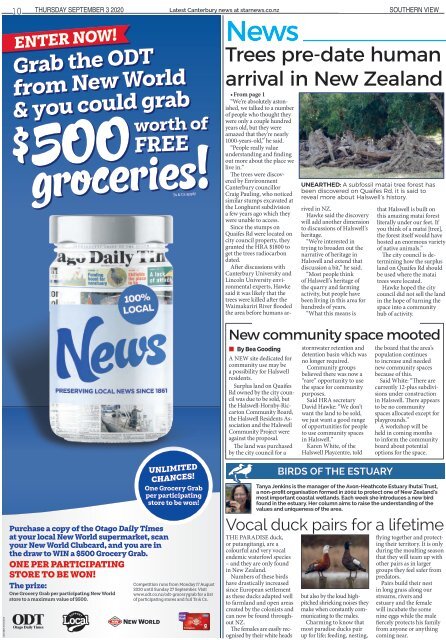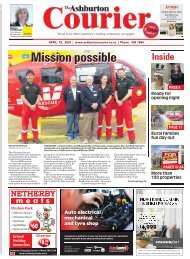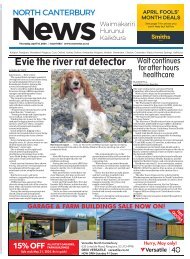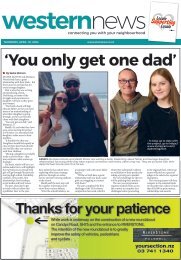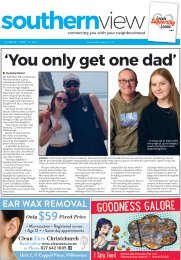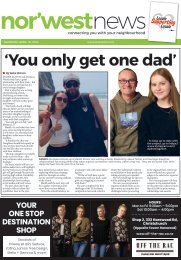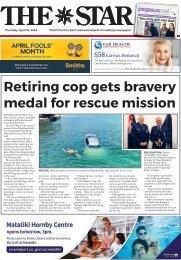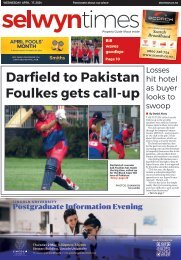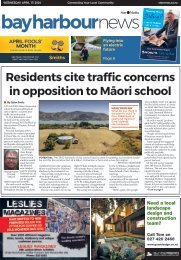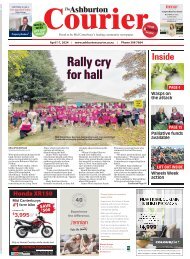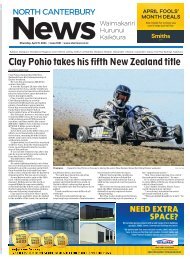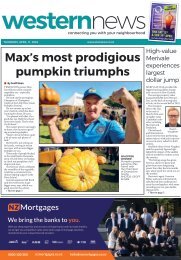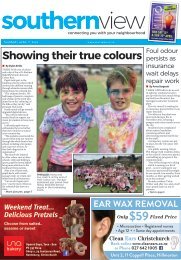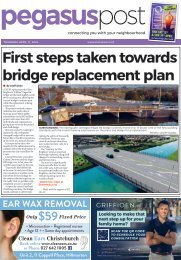Southern View: September 03, 2020
Create successful ePaper yourself
Turn your PDF publications into a flip-book with our unique Google optimized e-Paper software.
10 Thursday <strong>September</strong> 3 <strong>2020</strong><br />
Latest Canterbury news at starnews.co.nz<br />
SOUTHERN VIEW<br />
News<br />
Trees pre-date human<br />
arrival in New Zealand<br />
• By Bea Gooding<br />
A NEW site dedicated for<br />
community use may be<br />
a possibility for Halswell<br />
residents.<br />
Surplus land on Quaifes<br />
Rd owned by the city council<br />
was due to be sold, but<br />
the Halswell-Hornby-Riccarton<br />
Community Board,<br />
the Halswell Residents Association<br />
and the Halswell<br />
Community Project were<br />
against the proposal.<br />
The land was purchased<br />
by the city council for a<br />
UNEARTHED: A subfossil matai tree forest has<br />
been discovered on Quaifes Rd, it is said to<br />
reveal more about Halswell’s history.<br />
• From page 1<br />
“We’re absolutely astonished,<br />
we talked to a number<br />
of people who thought they<br />
were only a couple hundred<br />
years old, but they were<br />
amazed that they’re nearly<br />
1000-years-old,” he said.<br />
“People really value<br />
understanding and finding<br />
out more about the place we<br />
live in.”<br />
The trees were discovered<br />
by Environment<br />
Canterbury councillor<br />
Craig Pauling, who noticed<br />
similar stumps excavated at<br />
the Longhurst subdivision<br />
a few years ago which they<br />
were unable to access.<br />
Since the stumps on<br />
Quaifes Rd were located on<br />
city council property, they<br />
granted the HRA $1800 to<br />
get the trees radiocarbon<br />
dated.<br />
After discussions with<br />
Canterbury University and<br />
Lincoln University environmental<br />
experts, Hawke<br />
said it was likely that the<br />
trees were killed after the<br />
Waimakariri River flooded<br />
the area before humans arrived<br />
in NZ.<br />
Hawke said the discovery<br />
will add another dimension<br />
to discussions of Halswell’s<br />
heritage.<br />
“We’re interested in<br />
trying to broaden out the<br />
narrative of heritage in<br />
Halswell and extend that<br />
discussion a bit,” he said.<br />
“Most people think<br />
of Halswell’s heritage of<br />
the quarry and farming<br />
activity, but people have<br />
been living in this area for<br />
hundreds of years.<br />
“What this means is<br />
stormwater retention and<br />
detention basin which was<br />
no longer required.<br />
Community groups<br />
believed there was now a<br />
“rare” opportunity to use<br />
the space for community<br />
purposes.<br />
Said HRA secretary<br />
David Hawke: “We don’t<br />
want the land to be sold,<br />
we just want a good range<br />
of opportunities for people<br />
to use community spaces<br />
in Halswell.”<br />
Karen White, of the<br />
Halswell Playcentre, told<br />
that Halswell is built on<br />
this amazing matai forest<br />
literally under our feet. If<br />
you think of a matai [tree],<br />
the forest itself would have<br />
hosted an enormous variety<br />
of native animals.”<br />
The city council is determining<br />
how the surplus<br />
land on Quaifes Rd should<br />
be used where the matai<br />
trees were located.<br />
Hawke hoped the city<br />
council did not sell the land<br />
in the hope of turning the<br />
space into a community<br />
hub of activity.<br />
New community space mooted<br />
BIRDS OF THE ESTUARY<br />
the board that the area’s<br />
population continues<br />
to increase and needed<br />
new community spaces<br />
because of this.<br />
Said White: “There are<br />
currently 12-plus subdivisions<br />
under construction<br />
in Halswell. There appears<br />
to be no community<br />
spaces allocated except for<br />
playgrounds.’’<br />
A workshop will be<br />
held in coming months<br />
to inform the community<br />
board about potential<br />
options for the space.<br />
Tanya Jenkins is the manager of the Avon-Heathcote Estuary Ihutai Trust,<br />
a non-profit organisation formed in 2002 to protect one of New Zealand’s<br />
most important coastal wetlands. Each week she introduces a new bird<br />
found in the estuary. Her column aims to raise the understanding of the<br />
values and uniqueness of the area.<br />
Vocal duck pairs for a lifetime<br />
THE PARADISE duck,<br />
or putangitangi, are a<br />
colourful and very vocal<br />
endemic waterfowl species<br />
– and they are only found<br />
in New Zealand.<br />
Numbers of these birds<br />
have drastically increased<br />
since European settlement<br />
as these ducks adapted well<br />
to farmland and open areas<br />
created by the colonists and<br />
can now be found throughout<br />
NZ.<br />
The females are easily recognised<br />
by their white heads<br />
but also by the loud highpitched<br />
shrieking noises they<br />
make when constantly communicating<br />
to the males.<br />
Charming to know that<br />
most paradise ducks pair<br />
up for life; feeding, nesting,<br />
flying together and protecting<br />
their territory. It is only<br />
during the moulting season<br />
that they will team up with<br />
other pairs as in larger<br />
groups they feel safer from<br />
predators.<br />
Pairs build their nest<br />
in long grass along our<br />
streams, rivers and<br />
estuary and the female<br />
will incubate the some<br />
nine eggs while the male<br />
fiercely protects his family<br />
from anyone or anything<br />
coming near.


